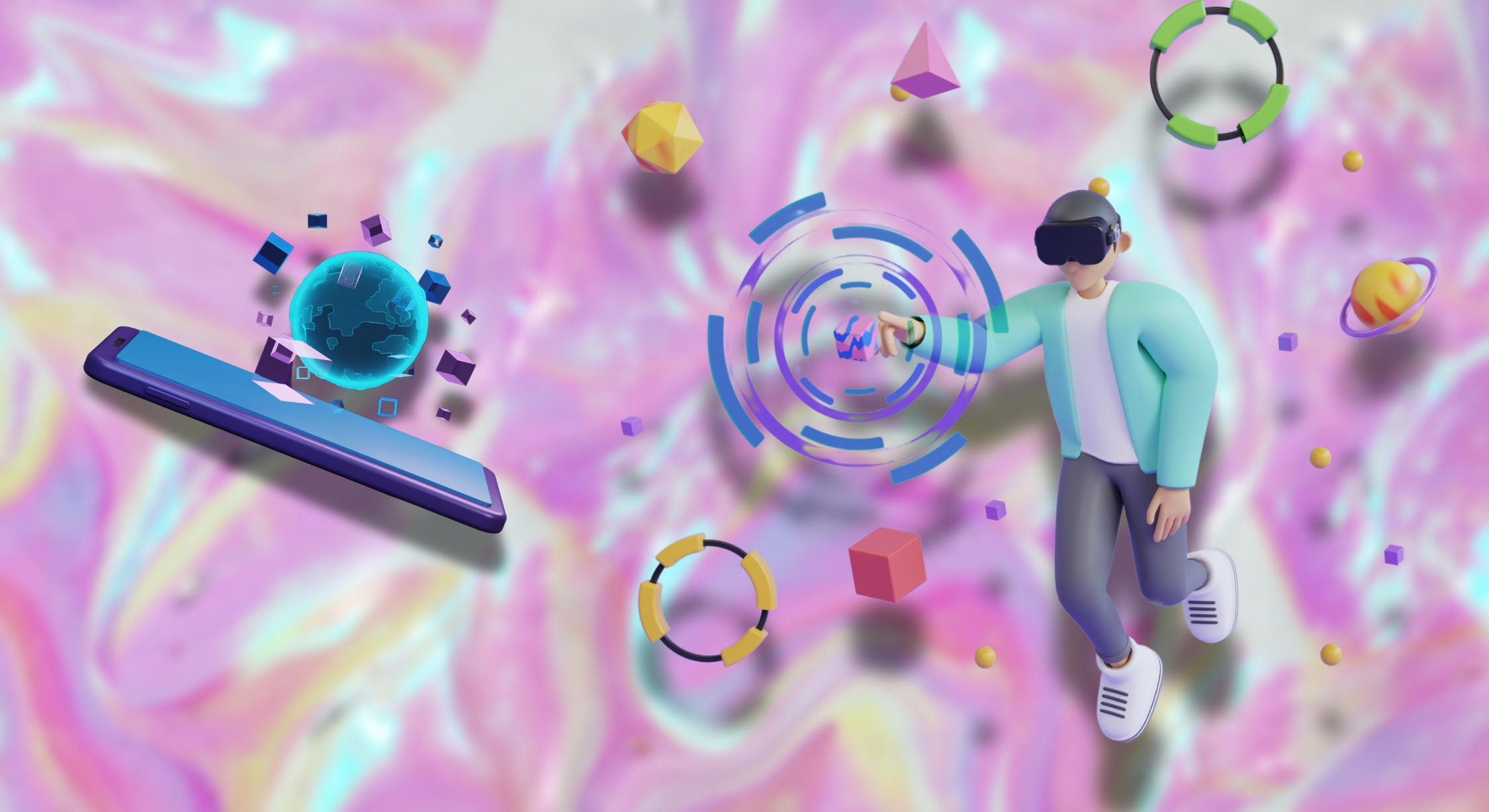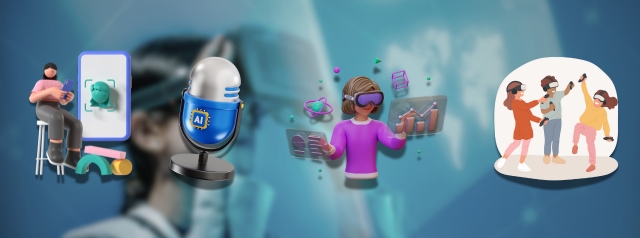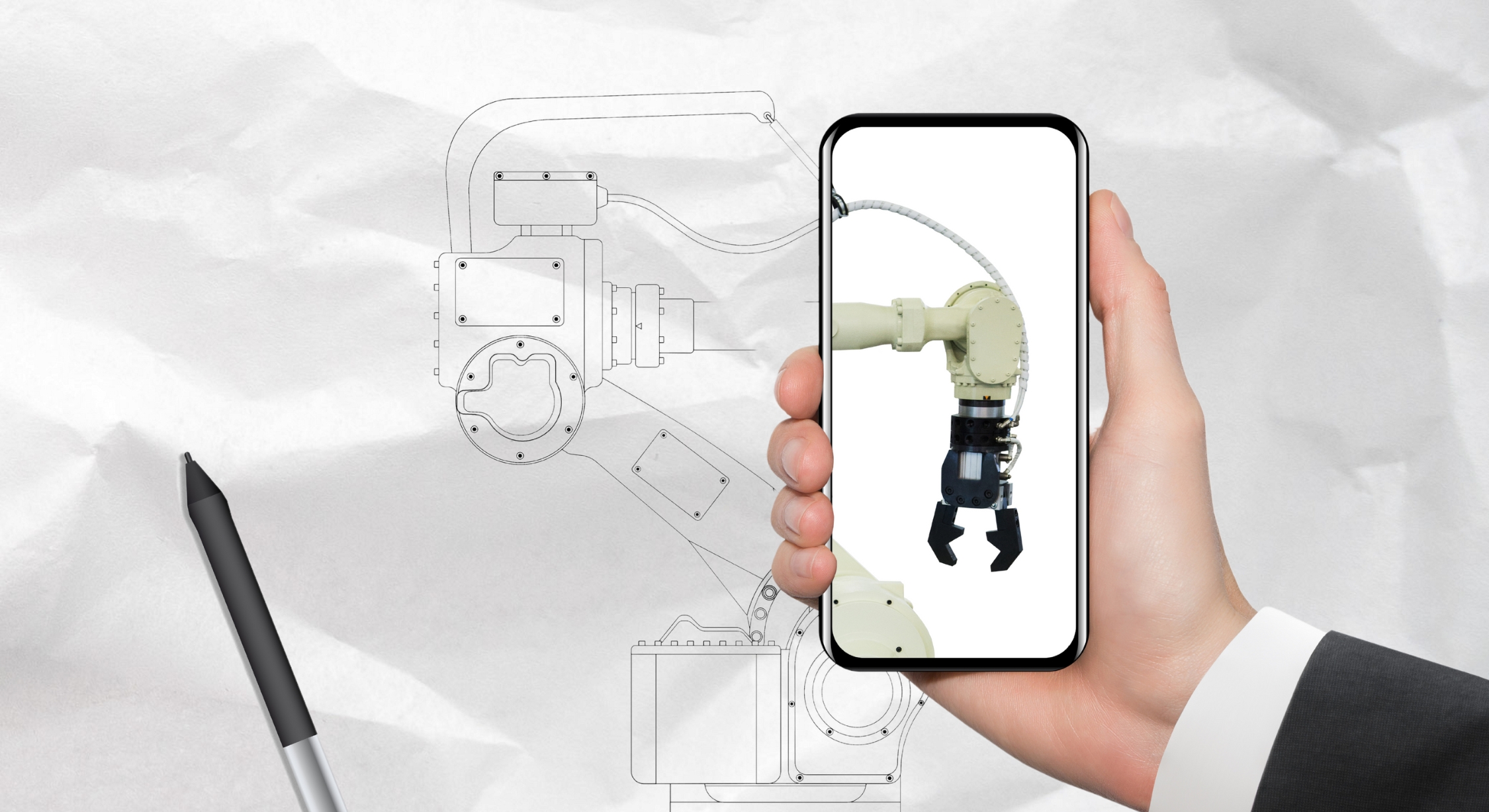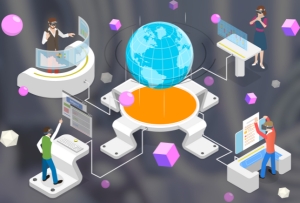At Experion, we harness cutting-edge Augmented Reality (AR) technology to craft innovative solutions that bridge the gap between the digital and physical worlds.
AR technology is no longer just a futuristic concept—it is reshaping industries, enabling brands to deliver unparalleled interactivity and personalization. From revolutionizing how customers shop online to redefining education with interactive learning tools, AR is becoming an integral part of our digital ecosystem.
In this blog, we delve into the exciting world of augmented reality app development, exploring its key features, processes, and potential to drive innovation. Whether you’re a business seeking to enhance user engagement or a developer aiming to create cutting-edge applications, this guide offers valuable insights into the immense possibilities AR holds.
What is Augmented Reality App Development?

Augmented Reality (AR) app development involves creating applications that overlay digital content, such as 3D objects, images, videos, or animations, onto the real-world environment. This technology enables users to interact with their physical surroundings enriched with virtual elements, using devices like smartphones, tablets, or specialized AR glasses.
Unlike Virtual Reality (VR), which immerses users completely in a simulated environment, or Mixed Reality (MR), which blends elements of AR and VR for a hybrid experience, AR keeps users rooted in the real world while enhancing it with digital interactions. This unique blend offers an engaging and practical way to deliver information, entertainment, or utility.
Some standout examples of augmented reality application development include Pokémon GO, which gamified AR for outdoor exploration; IKEA Place, which allows users to visualize furniture in their homes; and Snapchat filters, which use facial recognition to create fun, interactive overlays. These applications demonstrate how AR application development has revolutionized gaming, shopping, and social interactions, offering businesses and developers limitless possibilities for innovation.
Why Invest in Augmented Reality App Development?
- Enhanced User Experience
AR apps redefine user interaction by seamlessly integrating digital content with the physical world. This immersive approach creates memorable and engaging experiences. For instance, in retail, augmented reality mobile app development enables customers to virtually try on clothing or visualize furniture in their homes before making a purchase. Such tailored interactions increase customer satisfaction and boost sales.
- Industry Applications
The impact of custom AR app development is visible across diverse industries:
- Retail: Virtual Try-Ons, Product Visualization, and Interactive Showrooms
AR technology is transforming the shopping experience in the retail industry. One of the most significant advancements is the ability to virtually try on products before purchasing them. For instance, cosmetic brands and eyewear companies are integrating AR in their mobile apps, allowing customers to see how makeup or glasses will look on their face using their phone’s camera. Similarly, AR product visualization helps customers see how furniture, decor, or even clothing will look in their homes or on their bodies in real time. Companies like IKEA have already leveraged this feature, allowing users to view how furniture pieces would fit in their spaces before making a purchase. Additionally, interactive AR showrooms let customers explore products in 3D, giving them a more tactile and detailed experience than traditional online browsing. - Healthcare: AR-Guided Surgeries, Patient Education, and Medical Training
Augmented reality is also transforming healthcare by improving precision in surgeries, enhancing patient education, and offering advanced training for medical professionals. Surgeons use AR-guided surgeries to overlay critical information, such as imaging or 3D models, onto the patient’s body during procedures. This technique can improve the accuracy of complex surgeries by providing real-time visualization of underlying anatomy. For example, AR applications are used for neurosurgeries, where real-time scans of the brain are superimposed onto the patient’s body, allowing for better navigation and minimal invasiveness. Additionally, AR in medical training gives students the ability to practice procedures and anatomy visualizations interactively, improving understanding without requiring physical resources or cadavers. Patient education also benefits from AR as it helps patients better visualize their medical conditions or treatment options, leading to a greater understanding of their health status. - Education: AR-Powered Learning Modules
In the education sector, AR-powered learning modules offer new opportunities for interactive and engaging learning experiences. Traditional textbooks and diagrams are transformed into 3D models that students can explore and interact with, fostering deeper understanding and retention of knowledge. For example, AR apps can bring historical events to life or provide real-time simulations of scientific processes, making complex topics like biology, physics, or astronomy easier to grasp. In a classroom setting, AR enables students to manipulate virtual objects, participate in immersive educational games, or conduct virtual field trips to places like the Great Wall of China or outer space, all while staying engaged and excited about learning. Studies show that this type of learning increases retention by combining visual, auditory, and kinesthetic learning styles, which are especially effective for students with diverse learning needs. - Real Estate: Virtual Property Tours
In the real estate industry, AR technology has changed how properties are viewed and purchased. Virtual property tours allow potential buyers or renters to explore properties remotely, eliminating the need for multiple in-person showings. These tours offer highly detailed, interactive views of homes, allowing users to move through rooms, zoom in on specific features, and get a real sense of the space—all from their device. This technology not only saves time but also enhances the decision-making process by allowing clients to explore properties across different locations without ever leaving their home. Some AR real estate apps even allow buyers to modify the design of spaces—like changing wall colors or furniture arrangements—helping them visualize how a property can be customized to meet their needs. - Entertainment: AR Gaming and Storytelling
The entertainment industry has embraced AR to offer immersive experiences that captivate and engage audiences in novel ways. One of the most popular applications is AR gaming, where players interact with the real world while engaging in virtual gameplay. Popular games like Pokémon GO have integrated AR to allow users to catch virtual creatures in real-world environments, merging the digital and physical worlds. These games encourage players to be physically active while exploring their surroundings. Beyond gaming, AR is enhancing interactive storytelling by allowing audiences to engage with narratives in new formats. For instance, viewers can use AR apps to interact with 3D characters or objects that appear in their living rooms, adding layers of engagement to TV shows, movies, or live performances. This immersive approach to entertainment is growing rapidly, providing fresh avenues for content creators to experiment with storytelling and audience interaction.
- Market Trends
The global adoption of augmented reality app development is on a steep rise. The AR market is projected to surpass $97 billion by 2028, driven by the growing demand for AR app development solutions in both business and entertainment sectors. Industries increasingly leverage augmented reality mobile app development to enhance operations, customer engagement, and marketing efforts.
Furthermore, advancements in AR application development, such as cloud anchors, spatial mapping, and markerless AR, are setting new benchmarks for innovation. By investing in custom AR app development, businesses position themselves at the forefront of this technological wave, ready to deliver exceptional experiences and capture new market opportunities.
Embracing AR is not just a trend—it’s a strategic decision that transforms how businesses interact with their customers, making it a must-have for organizations looking to thrive in the digital era.
Features of an Augmented Reality App

3D Object Recognition
AR applications leverage 3D object recognition to detect and interact with real-world objects. This capability is critical for tasks such as identifying furniture in AR shopping apps or interacting with tools in AR-guided industrial training. By recognizing objects, AR apps can offer contextual information or enable virtual manipulation, enhancing user engagement and utility.
Gesture and Voice Recognition
Gesture recognition allows users to interact with AR applications using hand movements, creating an intuitive and immersive experience. For example, an AR app can detect a wave to select an option or a pinch motion to zoom. Voice recognition complements this by enabling hands-free commands, making AR apps more accessible and user-friendly. This is especially valuable in industries like healthcare, where touchless operation is essential.
Location-Based AR
Location-based AR integrates GPS and geospatial data to provide personalized and location-specific AR experiences. Navigation apps use this feature to guide users through interactive 3D directions, while tourism apps overlay historical data or points of interest onto real-world views, enhancing the exploration experience.
Camera and Motion Tracking
AR apps rely on advanced motion tracking and camera input to align digital objects with real-world environments. This technology ensures that virtual elements interact realistically with the user’s surroundings. For example, AR-based fitness apps use motion tracking to monitor body movements and guide users through exercises effectively.
Multi-User Support
Multi-user AR enables collaborative interactions in shared virtual spaces. In gaming, this feature allows multiple players to participate in the same AR game session. Similarly, team-based AR applications in fields like design or training facilitate real-time collaboration, increasing productivity and interactivity.
Real-Time Rendering
Real-time rendering ensures that AR apps deliver smooth, high-quality visuals without lag. This feature is crucial for applications like AR gaming, where seamless graphics are vital to maintaining immersion, or for educational tools that need to display detailed visualizations dynamically.
At Experion, we specialize in crafting custom AR app development solutions tailored to unique business needs. Whether it’s enhancing customer engagement through immersive experiences or optimizing operational workflows with innovative AR solutions, we ensure that our augmented reality mobile app development services drive measurable results.
Augmented Reality App Development Process

Step 1: Ideation and Conceptualization
The journey of augmented reality app development begins with defining the app’s purpose, target audience, and desired features. This stage involves understanding the specific business challenges AR can address and ensuring the app aligns with broader organizational goals. Detailed brainstorming, market research, and competitor analysis play crucial roles in shaping the concept.
Step 2: Design and Prototyping
This step focuses on crafting a seamless and intuitive UI/UX design tailored to AR interactions. The design process involves creating wireframes and prototypes to simulate user interactions and identify potential usability issues early on. Prototypes allow stakeholders to visualize the app’s functionality and refine the concept before moving into full-scale development.
Step 3: Development
Selecting the right development framework is critical platforms like Unity, ARKit (iOS), and ARCore (Android) offer tools to build robust AR applications. Development involves integrating AR capabilities such as motion tracking, environment mapping, and real-time rendering. Addressing technical challenges like ensuring smooth graphics, efficient performance, and accurate object placement is a priority during this phase.
Step 4: Testing and Optimization
Testing ensures that the app functions seamlessly across different devices and scenarios. This involves usability testing to evaluate user experience, performance testing to measure efficiency, and compatibility testing to confirm support for various hardware configurations. Optimization focuses on resolving issues like latency, ensuring smooth interactions, and refining overall functionality.
Step 5: Launch and Maintenance
Releasing an AR app involves meeting app store guidelines for publication on platforms like Google Play or the Apple App Store. Post-launch, regular updates are essential to incorporate user feedback, adapt to technological advancements, and maintain compatibility with newer devices or operating systems.
Challenges in AR App Development
Technical Challenges
Developing augmented reality applications comes with significant technical obstacles. One of the most pressing challenges is real-time rendering, where the app must render digital content in real-time and seamlessly overlay it on the physical world without lag or visual glitches. Similarly, environment tracking is crucial to ensure digital content interacts correctly with the real world, especially in dynamic environments where lighting, movement, and positioning can change. Achieving accurate object recognition is another hurdle, as AR apps need to identify and understand the objects in a user’s surroundings to display the correct information. These challenges demand highly optimized algorithms, powerful processing, and rigorous testing to ensure smooth and immersive experiences. Developers also need to account for varied environmental conditions, from low-light settings to complex urban environments, where AR interactions may be more challenging to achieve.
User Experience (UX) Challenges
While the potential for immersive user experiences in augmented reality app development is high, balancing immersion with practicality is often difficult. For AR to be effective, it must enhance the real-world environment without overwhelming or distracting users. Overcomplicated interactions or unnecessary digital layers can confuse users, leading to a poor experience. Additionally, contextual relevance is essential: AR apps should avoid irrelevant or disjointed virtual elements that disrupt the natural world. Developers must consider factors such as how intuitive the user interface is, the ease of navigation, and how naturally the app integrates with the real-world environment. Another UX challenge is ensuring that AR applications do not become tiresome or overwhelming. Excessive use of animations, 3D models, or visual overlays can fatigue users, detracting from the experience rather than enhancing it. Striking the right balance between interactive content and user comfort is crucial.
Hardware Limitations
Hardware limitations represent a significant barrier in augmented reality app development. Not all smartphones, tablets, or AR glasses have the required processing power, cameras, or sensors to support AR applications fully. For instance, some older devices may struggle with rendering 3D objects or tracking movements accurately. AR glasses, while promising, are still an emerging technology and remain relatively expensive and not widely adopted.
To overcome this, developers must ensure their AR apps are optimized for a wide range of devices. This includes accounting for performance constraints on lower-end smartphones and ensuring cross-platform compatibility. Apps must be designed to provide a consistent experience across different device capabilities, which can sometimes mean sacrificing advanced features or reducing graphics quality.
Privacy and Data Security
Privacy and data security are paramount concerns in AR app development. AR apps often collect and process sensitive data, such as users’ location, visual surroundings, and interactions with physical objects. This data can be used to enhance the user experience, but it also raises potential privacy risks. Users may be concerned about how their data is collected, stored, and shared with third parties.
Moreover, ensuring compliance with privacy regulations such as the GDPR (General Data Protection Regulation) in Europe or CCPA (California Consumer Privacy Act) is essential. AR app developers must be transparent about what data they collect and how it is used. They also need to implement robust security measures, such as encryption and data anonymization, to protect user information and avoid data breaches. Addressing these concerns head-on and providing clear privacy policies are critical steps in building trust with users.
In conclusion, while augmented reality app development offers immense opportunities, overcoming the technical, user experience, hardware, and privacy challenges is essential for creating successful and sustainable AR applications. By addressing these issues thoughtfully, developers can unlock the full potential of AR technology and provide users with seamless, immersive experiences.
Best Practices for a Successful AR App
1. Design Intuitive Interactions
A successful augmented reality app prioritizes user-friendly design. AR applications should focus on creating clear, simple, and intuitive interactions. Overcomplicated interfaces or controls can deter users, while thoughtful design fosters engagement. For example:
- Use clear navigation and tooltips to guide users.
- Keep interactions natural, leveraging gestures or voice commands where appropriate.
- Ensure visual elements blend seamlessly with real-world environments for a cohesive experience.
2. Enable Cross-Platform Compatibility
To reach a broader audience, AR apps must work efficiently across multiple platforms, including Android, iOS, and web-based applications. Leveraging frameworks like Unity and Unreal Engine ensures compatibility and reduces development efforts. Cross-platform support not only maximizes user reach but also ensures the app performs well on various devices, catering to different hardware capabilities.
3. Leverage Analytics
Analytics play a vital role in the continuous improvement of AR apps. By tracking user behavior, engagement metrics, and technical performance, developers can identify areas for enhancement:
- Collect data on how users interact with AR features.
- Identify and resolve pain points, such as navigation issues or performance bottlenecks.
- Use insights to add or refine features, keeping the app aligned with user expectations.
4. Optimize Performance
AR apps require robust performance optimization to provide seamless experiences. Prioritizing real-time rendering ensures smooth visuals, even for dynamic or resource-intensive interactions. Key strategies include:
- Leveraging device-specific features like LiDAR for better spatial mapping.
- Minimizing app latency to keep AR interactions responsive.
- Using lightweight, optimized assets to reduce load times without compromising quality.
The Future of Augmented Reality App Development

The future of AR development is propelled by rapid technological advancements, enabling richer and more immersive experiences. Here are some of the most exciting trends shaping AR’s trajectory:
5G Connectivity
The widespread adoption of 5G networks is a game-changer for AR. With its ultra-low latency and high bandwidth, 5G enables smoother, more responsive AR applications, even for data-intensive use cases like:
- Real-time multiplayer AR games.
- Remote AR-assisted training or support.
- Complex, location-based AR experiences.
AI-Powered Interactions
Artificial intelligence (AI) is transforming AR apps by enabling smarter, more context-aware interactions. AI enhances AR capabilities in multiple ways:
- Advanced object recognition allows apps to interact more naturally with real-world items.
- AI-driven personalization tailors AR content to individual users.
- Sophisticated natural language processing (NLP) supports voice-based commands and conversations.
Wearable AR Devices
Emerging wearable technologies, such as AR glasses (e.g., HoloLens, Magic Leap), are set to redefine how we experience AR:
- Wearables free users from holding devices, enabling hands-free, immersive interactions.
- Industries like healthcare, manufacturing, and retail are exploring use cases for AR glasses, from virtual surgeries to inventory management.
- As wearables become more affordable, they are likely to revolutionize consumer markets, offering everyday applications like navigation or entertainment.
Opportunities for Businesses and Developers
The convergence of AR with technologies like cloud computing, IoT, and blockchain presents unprecedented opportunities. For instance:
- Businesses can integrate AR with IoT devices for interactive smart home controls.
- Blockchain-based AR apps can secure transactions in virtual marketplaces.
AR is not just a trend—it’s becoming a staple for industries aiming to offer innovative, engaging user experiences.
How Experion Global Can Help You

At Experion, we combine technical expertise with creative innovation to craft custom AR app development solutions tailored to your business needs. From concept to execution, we specialize in developing applications that leverage cutting-edge AR technologies to create immersive, impactful experiences. Our team excels in delivering AR solutions for various industries, including retail, healthcare, education, and entertainment. With Experion, you can turn your vision into reality and stay ahead in the competitive market of augmented reality mobile app development.
Conclusion
Augmented reality application development is transforming industries by integrating the virtual and physical worlds to deliver immersive, interactive, and highly engaging digital experiences. From enabling 3D product visualization in retail to revolutionizing healthcare procedures with AR-guided surgeries, augmented reality mobile app development is paving the way for innovative business solutions. Its applications extend to education, making learning more interactive, and to real estate, simplifying property tours through virtual experiences.
By investing in custom AR app development, businesses can unlock untapped potential to engage users in ways never imagined before. AR apps enhance operational efficiency, elevate customer satisfaction, and help organizations gain a competitive edge in the digital-first era. With augmented reality application development, businesses can achieve goals ranging from brand differentiation to deeper customer engagement, all while staying aligned with the latest technological advancements.
Key Takeaways
- Elevated User Experience: AR apps create captivating and intuitive interactions by overlaying digital content onto the real world, enriching customer experiences.
- Cross-Industry Applications: Industries such as retail, healthcare, real estate, education, and entertainment are leveraging AR to redefine customer engagement and operational strategies.
- Advanced Features: AR apps today boast cutting-edge functionalities like 3D object recognition, gesture and voice controls, real-time rendering, and location-based experiences, ensuring seamless interaction.
- Emerging Technologies: Tools such as LiDAR sensors, spatial mapping, and cloud anchors are pushing the boundaries of augmented reality mobile app development, enabling precision and scalability.
- Strategic Development Process: From ideation to testing and post-launch updates, a structured AR app development process ensures that applications are both innovative and functional.
- Overcoming Challenges: Despite hurdles like hardware limitations, real-time rendering, and data privacy concerns, adopting best practices ensures AR apps are intuitive, secure, and efficient.
- Technological Synergy: Advances in 5G connectivity, AI integration, and wearable AR devices are expanding the scope of AR solutions, offering smarter and more personalized applications.
- Future-Proof Business Strategies: Companies embracing augmented reality app development position themselves as industry leaders, ready to meet evolving market and consumer demands.
- End-to-End Expertise: With Experion Technologies, businesses can leverage proven expertise in custom AR app development to build tailored solutions that drive growth, engagement, and innovation.
At Experion Technologies, we specialize in developing future-ready AR solutions that are aligned with your unique business goals. Let us partner with you to explore and maximize the immense potential of augmented reality application development.

